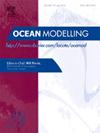The simulation of the South China Sea by the variable resolution version of the global ocean general circulation model LICOM3.0
IF 2.9
3区 地球科学
Q2 METEOROLOGY & ATMOSPHERIC SCIENCES
引用次数: 0
Abstract
We develop a variable-resolution method based on the tripolar grid to achieve fine-resolution regional simulations with limited computational resources. Based on the global ocean general circulation model LICOM3.0, we select the South China Sea (SCS) as the refined area and design five experiments to assess the impact of the variable-resolution grid on oceanic simulation. The results show that the method can retain the model capacity for global ocean simulation and obtain results in the refined region comparable to the reference global high-resolution model. Improving the resolution in the SCS from 0.1° to 0.02° significantly enhances the model performance in simulating submesoscale phenomena. The model can effectively reproduce submesoscale processes generated by frontogenesis, topographic wakes, and their seasonal variation. We uncover the effect of the submesoscale vortex train near the Luzon Strait. In summer, the vortex train tends to carry positive vorticity westward into the SCS and constrain the negative vorticity along the Kuroshio Current. In winter, the vortex train is more intrusive into the SCS with enhanced filament activities.
全球海洋环流变分辨率模式LICOM3.0对南海的模拟
本文提出了一种基于三极网格的变分辨率方法,在有限的计算资源下实现精细分辨率的区域模拟。基于全球海洋环流模式LICOM3.0,我们选择南海(SCS)作为精细化区域,设计了5个实验来评估变分辨率网格对海洋模拟的影响。结果表明,该方法能够保持模型对全球海洋模拟的能力,并在精细化区域得到与参考全球高分辨率模式相当的结果。将南海的分辨率从0.1°提高到0.02°,可以显著提高模式模拟亚中尺度现象的性能。该模式能有效再现锋生、地形尾流及其季节变化所产生的亚中尺度过程。揭示了吕宋海峡附近亚中尺度涡旋的影响。夏季,涡列向西携带正涡度进入南海,并沿黑潮方向抑制负涡度。冬季,涡旋序列对南海的侵入性增强,细丝活动增强。
本文章由计算机程序翻译,如有差异,请以英文原文为准。
求助全文
约1分钟内获得全文
求助全文
来源期刊

Ocean Modelling
地学-海洋学
CiteScore
5.50
自引率
9.40%
发文量
86
审稿时长
19.6 weeks
期刊介绍:
The main objective of Ocean Modelling is to provide rapid communication between those interested in ocean modelling, whether through direct observation, or through analytical, numerical or laboratory models, and including interactions between physical and biogeochemical or biological phenomena. Because of the intimate links between ocean and atmosphere, involvement of scientists interested in influences of either medium on the other is welcome. The journal has a wide scope and includes ocean-atmosphere interaction in various forms as well as pure ocean results. In addition to primary peer-reviewed papers, the journal provides review papers, preliminary communications, and discussions.
 求助内容:
求助内容: 应助结果提醒方式:
应助结果提醒方式:


